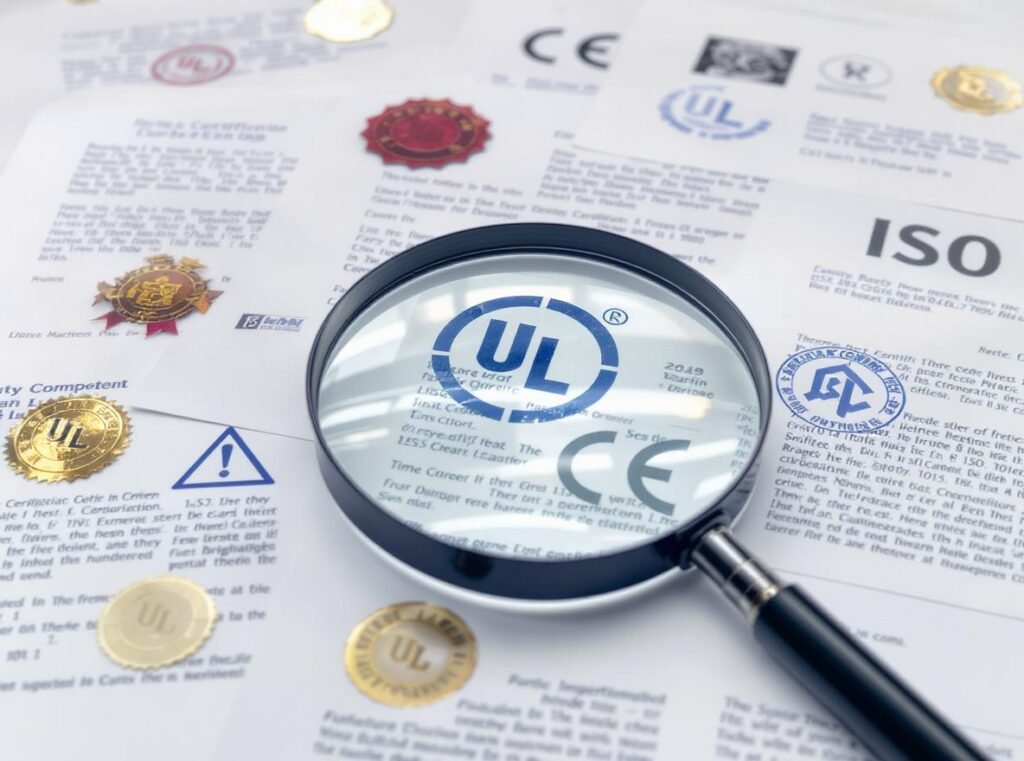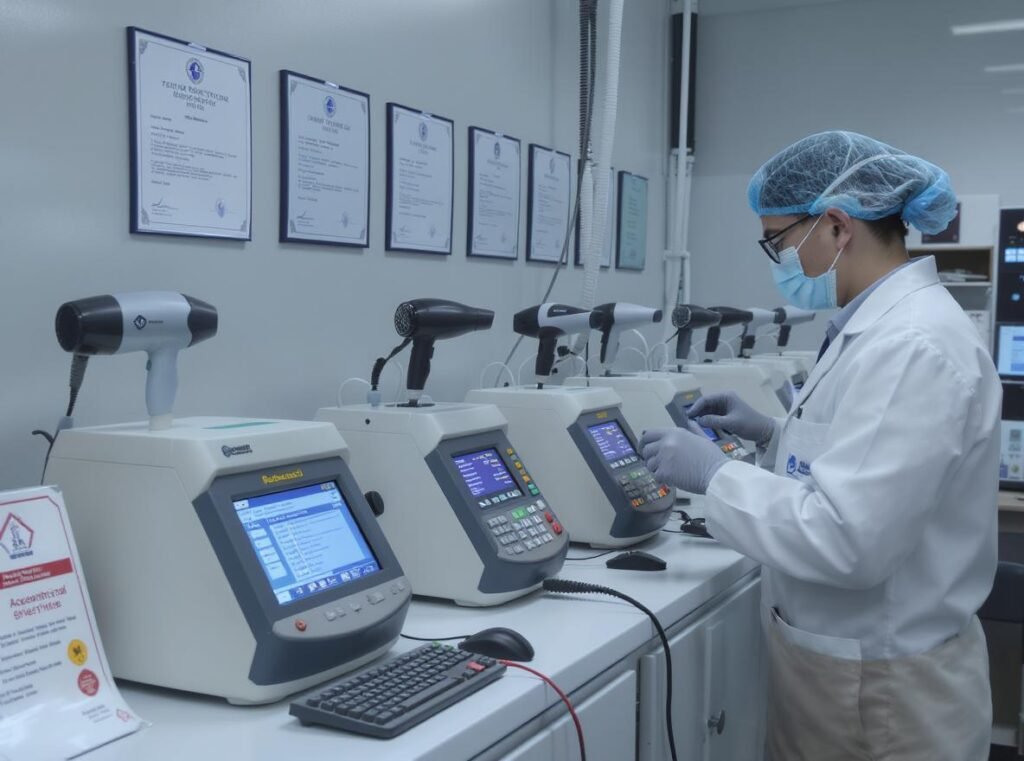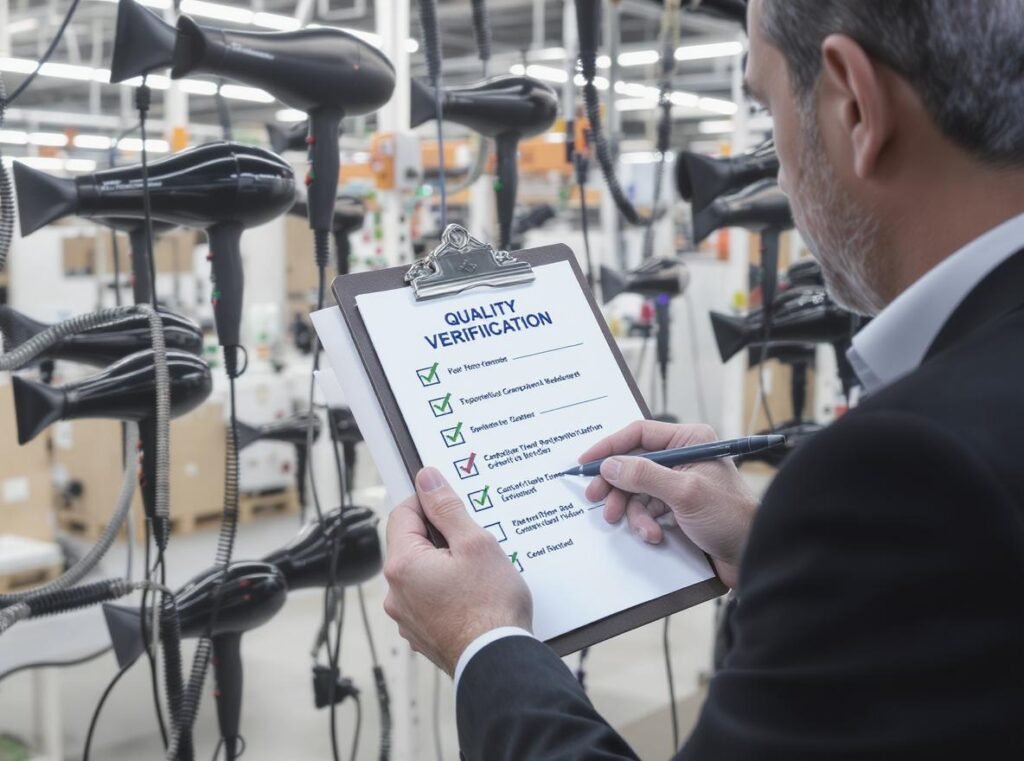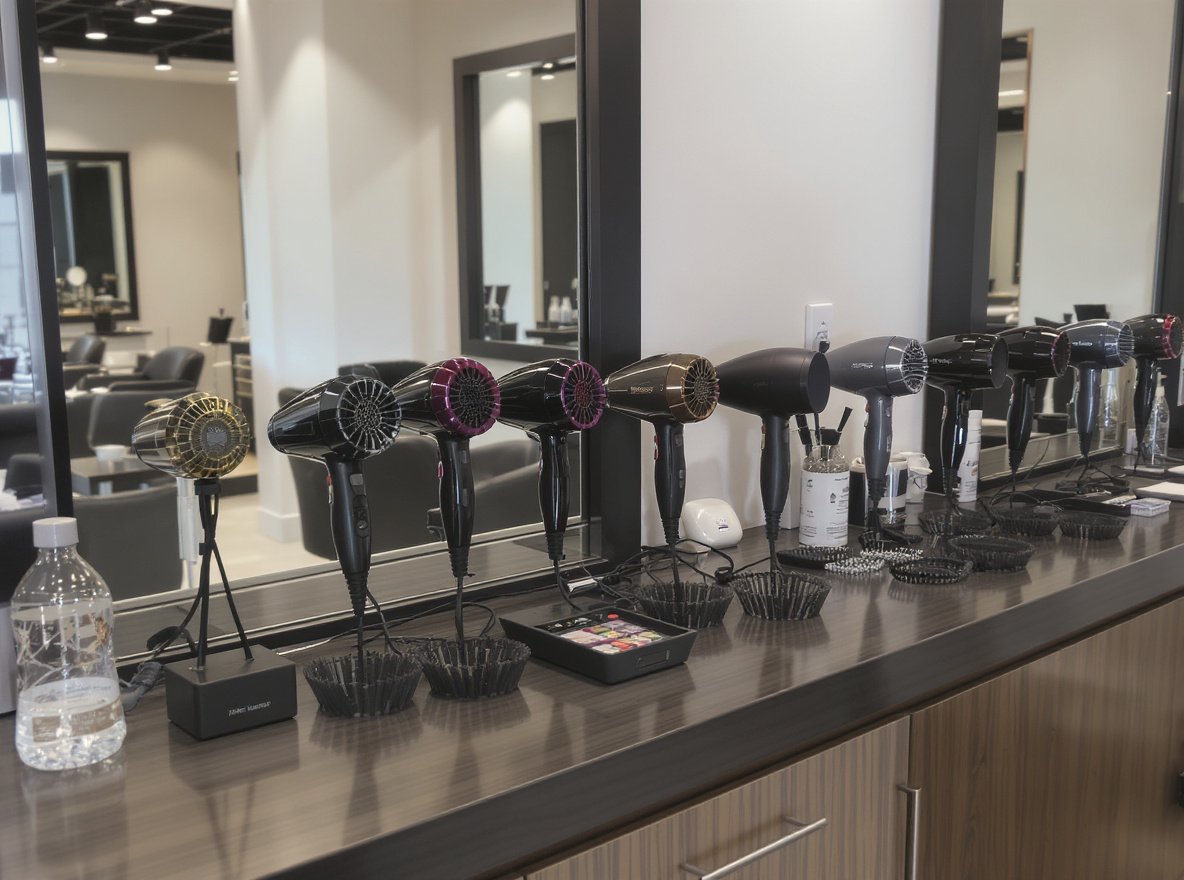Choosing the right hair dryer manufacturer is crucial for your business success, but how can you ensure they meet quality standards? Poor manufacturing can lead to product recalls, customer complaints, and damaged reputation. The solution lies in establishing partnerships with certified factories that comply with international standards and implementing systematic quality verification methods.
B2B buyers can verify quality control by establishing partnerships with certified factories that comply with ISO 9001, CE, and RoHS standards, conducting comprehensive factory audits, and requesting sample evaluations before finalizing contracts. Key verification includes examining quality management systems, testing capabilities, and supplier performance metrics.
Let’s explore the comprehensive steps to verify manufacturer quality and protect your business interests.
Table of Contents
ToggleWhat Are the Essential Safety Certifications for Hair Dryer Manufacturers?
Understanding safety certifications is your first line of defense when evaluating potential manufacturing partners. These certifications directly impact your ability to sell products legally and safely in different markets.
Essential certifications include UL 859 or UL 1727 for US markets (requiring integral immersion protection), CE marking for European compliance (covering LVD, EMC, and RoHS directives), and ISO 9001:2015 for quality management systems. These certifications demonstrate adherence to international safety and quality standards.

Critical Safety Standards by Market
For the United States market, hair dryers must comply with UL 859 (Standard for Household Electric Personal Care Appliances) or UL 1727 (Standard for Commercial Electric Personal Care Appliances). These standards mandate that hand-supported hair dryers be equipped with integral immersion protection that reduces the risk of electric shock if the dryer contacts water.
European markets require CE certification, which involves three primary directives: CE-LVD (Low Voltage Directive), CE-EMC (Electromagnetic Compatibility), and CE-RoHS (Restriction of Hazardous Substances). The CE-LVD directive tests electrical safety performance including electrical insulation, mechanical strength, temperature rise limits, and fire resistance.
Global markets require compliance with IEC 60335-2-23 safety standards and CISPR 14-1, CISPR 14-2 electromagnetic compatibility standards. For Indian markets, manufacturers need BIS certification according to IS 616 standards.
Immersion Protection Requirements
The most critical safety requirement is immersion protection, which prevents potentially fatal electric shock accidents. Products must include either IDCI (Immersion Detection Circuit Interrupter) or GFCI (Ground Fault Circuit Interrupter) protection.
Additional important certifications include:
- ETL (Electrical Testing Laboratories): Provides independent safety inspection according to UL standards and Canadian CSA standards
- ISO 9001:2015: Demonstrates commitment to quality management and continuous improvement
- FCC Certification: Required for electromagnetic compatibility in North America
| Market | Required Certification | Key Safety Features |
|---|---|---|
| United States | UL 859/1727 | Integral immersion protection, IDCI/GFCI |
| European Union | CE (LVD, EMC, RoHS) | Electrical safety, EMC compliance, hazardous substance restrictions |
| Global | IEC 60335-2-23 | International safety standards |
| India | BIS IS 616 | Local safety compliance |
Always verify certification authenticity directly with issuing bodies and ensure certificates are current and valid for your target markets.
How Do You Conduct Effective Factory Audits for Hair Dryer Manufacturing?
Factory audits provide crucial insights into manufacturing capabilities and quality control processes that certifications alone cannot reveal. Effective audits should follow ISO 9000 standards best practices to ensure efficient quality management systems evaluation.
Effective factory audits should cover three key elements: productivity assessment, quality control systems evaluation, and manufacturing capability verification. The audit should examine workflow organization, quality assurance systems, facility conditions, and the manufacturer’s ability to meet production and quality requirements consistently.

Pre-Audit Preparation Framework
Before conducting any factory visit, prepare a comprehensive audit checklist covering essential evaluation areas. The audit should assess production processes, track time spent finishing products, and evaluate the efficiency of machines and manufacturing equipment.
Standard manufacturing audit components should include factory profile assessment, production capacity evaluation, factory facilities review, and quality assurance systems verification. Auditors should examine the condition of machinery, equipment workflow, and organizational structure.
Key audit preparation areas include:
- Factory profile and organizational structure assessment
- Production capacity and workflow evaluation
- Quality assurance systems and control processes
- Manufacturing equipment condition and maintenance
- Personnel training and competence verification
- Social responsibility and environmental compliance
Critical Audit Focus Areas
During factory visits, concentrate on evaluating quality management systems, organization structure, production processes, and compliance with safety measures. The audit should verify the manufacturer’s ability to deliver products on time while maintaining quality standards.
Quality Control Department: Verify that manufacturers have professional quality teams available to ensure products are produced according to specifications and customer requirements.
Documentation Systems: Examine whether comprehensive quality documentation is maintained, including quality policies, procedures, and records that demonstrate systematic quality management.
Continuous Improvement: Look for evidence of corrective and preventive action (CAPA) systems, internal audits, and management reviews that drive ongoing quality improvements.
| Audit Component | Assessment Criteria | Quality Indicators |
|---|---|---|
| Quality Systems | ISO 9001 compliance, documented procedures | Systematic quality management, regular reviews |
| Production Capacity | Equipment utilization, workflow efficiency | Optimal capacity without quality compromise |
| Personnel Training | Competency records, ongoing development | Skilled workforce, quality awareness |
Audit Documentation and Follow-up
Auditors should provide comprehensive evaluation reports with specific recommendations for each process and conduct detailed gap analysis. The audit should result in a corrective action plan with prioritized key remediations, realistic timelines, and agreed-upon KPIs.
Annual factory inspections should determine if products fulfill requirements and enable objective comparison of potential suppliers. Follow-up audits verify implementation of corrective actions and continuous improvement progress.
What Quality Management Systems Should Hair Dryer Manufacturers Have?
Quality management systems form the foundation of consistent manufacturing excellence. Hair dryer manufacturers should implement comprehensive QMS based on ISO 9001:2015 standards to organize quality management, foster customer satisfaction, and drive continuous improvement.
Manufacturers should implement ISO 9001:2015 quality management systems that include documented procedures, corrective and preventive action (CAPA) processes, supplier management, and continuous improvement programs. The QMS should be a structured system of policies, processes, procedures, and records designed to manage quality throughout the manufacturing lifecycle.

Core QMS Components and Implementation
Essential QMS processes include document control, change control, training management, deviation and nonconformance management, CAPA management, audits management, and supplier management. The system should ensure products comply with regulatory and customer requirements while enhancing product quality, reliability, and process efficiency.
Process Approach Implementation: The QMS should employ a process approach that incorporates the Plan-Do-Check-Act (PDCA) cycle and risk-based thinking. This enables organizations to plan processes and their interactions while ensuring adequate resource management and identifying improvement opportunities.
Risk Management: The system should address factors that could cause processes to deviate from planned results and implement preventive controls to minimize quality risks.
Core QMS elements include:
- Quality policy and objectives establishment
- Document control and change management systems
- Training programs and competency management
- Deviation handling and nonconformance control
- Corrective and preventive action (CAPA) processes
- Internal audit programs and management reviews
- Supplier qualification and performance management
Documentation Requirements and Control
Good documentation constitutes an essential part of the quality assurance system. Documents must be designed, prepared, reviewed, and distributed with appropriate approval, signatures, and dates from authorized persons.
Critical Documentation should include quality policies and objectives, quality manual with QMS scope, documented quality procedures, computer software validation procedures, and comprehensive quality records covering all processes.
Record Keeping: Records must be maintained when each action is taken to ensure all activities are traceable. Critical records should be stored securely with limited access to authorized persons and adequate protection from loss, destruction, or falsification.
| Documentation Type | Purpose | Retention Requirements |
|---|---|---|
| Quality Manual | QMS scope and procedures | Current version control |
| Process Records | Activity traceability | Secure storage, limited access |
| Training Records | Personnel competency | Ongoing documentation |
| Audit Reports | System effectiveness | Regular reviews and updates |
How Can You Verify Testing Capabilities and Laboratory Accreditation?
Testing capabilities determine whether manufacturers can consistently produce safe, compliant products. Laboratory accreditation provides confidence that test results are accurate, reliable, and internationally recognized.
Manufacturers should have ISO/IEC 17025 accredited testing laboratories or partnerships with accredited third-party labs. ISO/IEC 17025 is the single most important standard for calibration and testing laboratories worldwide, demonstrating technical proficiency and ability to produce precise and accurate test data.

Laboratory Accreditation Standards
ISO/IEC 17025:2017 specifies general requirements for competence, impartiality, and consistent operation of laboratories. The standard applies to all organizations performing laboratory activities regardless of personnel number and promotes confidence in laboratory operations.
Accreditation Verification: Laboratory accreditation should include management requirements related to quality management system operation and technical requirements determining test correctness and reliability. Many suppliers and regulatory authorities will not accept results from non-accredited laboratories.
Method Validation: Laboratories must validate non-standard, laboratory-developed, or significantly modified methods before use to ensure reliable and accurate results.
Testing Standards by Market
Hair dryer testing should follow country-specific safety and EMC standards to ensure market compliance:
European Markets: EN60335-1 and EN60335-2-23 safety standards plus EN55014-1 and EN55014-2 electromagnetic compatibility standards
US Markets: UL60335-1 and UL60335-2-23 safety standards with additional UL 859 or UL 1727 requirements
Global Standards: IEC 60335-2-23 safety standards and CISPR 14-1, CISPR 14-2 electromagnetic compatibility standards
Essential Testing Capabilities
Manufacturers should demonstrate comprehensive testing capabilities covering all critical performance and safety parameters:
- Electrical safety testing (insulation resistance, leakage current, grounding)
- Immersion protection verification (IDCI/GFCI functionality)
- Performance testing (airflow, temperature, power consumption)
- Durability testing (switch life, cord flex, drop tests)
- Electromagnetic compatibility (EMC) testing
- Material safety testing (flame resistance, chemical emissions)
| Testing Category | Required Standards | Verification Method |
|---|---|---|
| Electrical Safety | UL 859, EN60335-2-23 | Accredited lab reports |
| EMC Compliance | EN55014, FCC Part 15 | Certified test results |
| Performance | Manufacturer specs | Witnessed testing |
| Durability | IEC standards | Long-term test data |
What Documentation Should Manufacturers Provide for Quality Verification?
Comprehensive documentation demonstrates transparency and provides evidence of systematic quality control implementation. Quality documentation refers to organized records and documents that describe processes, procedures, standards, and outcomes related to product quality.
Manufacturers should provide technical documentation including manufacturer details, product descriptions, conformity assessment procedures, EU declarations of conformity, test results, and compliance statements. This documentation must be prepared before placing products on the market and kept for 10 years.

Essential Documentation Categories
Technical Documentation Requirements: Manufacturer name and address, detailed product description, product identification systems, facility information, conformity assessment procedures, EU declaration of conformity, comprehensive test results, and compliance statements.
Quality System Documentation: Quality Management System documentation should include quality policy and objectives, quality manual with QMS scope, documented quality procedures, quality records covering all processes, computer software validation procedures, and medical device files where applicable.
Traceability Records: Records must be kept when each action is taken to ensure all activities are traceable throughout the manufacturing process.
Critical documentation categories include:
- Quality manual and standard operating procedures
- Supplier qualification and approval records
- Production batch records and quality control data
- Test reports from accredited laboratories
- Corrective action reports and improvement plans
- Customer complaint logs and resolution records
- Certification documents and compliance statements
Document Control and Verification
Cross-reference different documents to ensure consistency and accuracy. Production records should match quality control data, and test reports should align with certification claims.
Version Control: Verify that all documents are current versions and properly controlled. Outdated procedures can lead to quality problems and regulatory non-compliance.
Data Integrity: Data may be recorded electromagnetically or photographically, but detailed procedures must be available with accuracy verification methods.
Security Requirements: Critical records must be stored in secure locations with limited access to authorized persons, ensuring adequate protection from loss, destruction, or falsification.
| Document Type | Purpose | Retention Period |
|---|---|---|
| Technical Files | Market compliance | 10 years |
| Quality Records | Process traceability | As per regulations |
| Test Reports | Performance verification | Ongoing reference |
| Audit Reports | System effectiveness | Regular updates |
How Do You Assess Supplier Quality Management and Control?
Supplier quality directly impacts final product quality and your business reputation. Effective supplier quality management assessment requires implementing consistent KPIs to assess all suppliers against industry requirements and customer needs.
Effective supplier management includes qualification procedures, performance monitoring, regular audits, and corrective action processes. Assessment should use efficient and experienced auditors strategically located in key sourcing countries to provide cost efficiencies and faster execution.

Supplier Performance Metrics and KPIs
Key supplier performance indicators include on-time delivery rate, quality rate, lead time, order accuracy rate, cost savings, supplier availability, supplier responsiveness, and supplier flexibility. Defect rates should measure the percentage of defective products received to assess supplier quality consistency.
Real-time Monitoring: Supplier quality management requires real-time monitoring of performance metrics to enable quick decision-making and address issues as they occur. Reliable suppliers enable accurate inventory forecasts and secure production schedules.
Performance Benchmarking: On-time delivery rate evaluates the supplier’s ability to meet required delivery dates, while quality metrics assess product conformance to specifications.
Essential supplier assessment areas include:
- Quality management systems implementation
- Risk assessment and mitigation procedures
- Personnel training and competence verification
- Infrastructure management and maintenance
- Customer focus and communication systems
- Procurement and supplier management processes
- Process control and continuous improvement
Supplier Qualification Framework
Supplier assessment should evaluate quality management systems, implementation of risk assessment, personnel training and competence, infrastructure management, customer focus, procurement and supplier management, and process control.
Continuous Improvement: The assessment should cover packaging, storage and delivery processes, final inspection and testing procedures, non-conforming product control, and internal audit management.
Supply Chain Integration: Evaluate communication and coordination between commercial, production, quality, methods, logistics, and purchasing functions to ensure seamless operations.
| Performance Area | Key Metrics | Target Performance |
|---|---|---|
| Quality | Defect rate, first pass yield | <1% defect rate |
| Delivery | On-time delivery rate | >95% on-time |
| Responsiveness | Lead time, flexibility | Consistent improvement |
| Cost | Cost savings, efficiency | Ongoing optimization |
What Are the Key Performance Indicators for Manufacturing Quality?
Manufacturing quality KPIs provide objective measures of production effectiveness and help predict future performance. These metrics should focus on Overall Equipment Effectiveness (OEE) monitoring, First Pass Yield quantification, Process Capability Index (Cpk) analysis, and Mean Time Between Failures (MTBF) tracking.
Important KPIs include defect rates, first pass yield, customer satisfaction ratings, process capability studies, and measurement system analysis. Defect rates should be calculated by dividing defective units by total units delivered, with low defect rates below 1% signaling robust quality control.

Core Quality Metrics and Calculations
Defect Rate Calculation: Defect rates should be calculated by dividing defective units by total units delivered, then multiplying by 100. A low defect rate below 1% signals robust quality control, while higher rates indicate systemic issues requiring immediate attention.
Process Capability Studies: Manufacturing quality assessment should include Statistical Process Control (SPC), variance analysis of process parameters, system stability monitoring, and trend analysis. Process capability studies should evaluate Cp (potential capability) and Cpk (actual capability considering any shift from center).
First Pass Yield: This metric measures the percentage of products that pass quality inspection on the first attempt, indicating manufacturing process stability and quality control effectiveness.
Critical quality KPIs include:
- Overall Equipment Effectiveness (OEE) monitoring
- First Pass Yield (FPY) quantification
- Process Capability Index (Cpk) analysis
- Mean Time Between Failures (MTBF) tracking
- Customer satisfaction ratings and feedback
- Statistical Process Control (SPC) compliance
- Corrective action response times and effectiveness
Resource Efficiency and Performance Tracking
Quality KPIs should measure energy efficiency, material usage rates, labor productivity, and equipment downtimes. Lead time performance monitoring is vital as shorter lead times contribute to more responsive supply chains.
Cost Performance: Cost savings metrics should track supplier contributions to cutting supply chain costs while maintaining quality standards.
Process Stability: System stability monitoring and trend analysis help identify potential quality issues before they impact production or customer satisfaction.
| KPI Category | Measurement Method | Target Range |
|---|---|---|
| Defect Rate | (Defective units / Total units) × 100 | <1% |
| First Pass Yield | (Units passing first inspection / Total units) × 100 | >95% |
| Process Capability | Cpk calculation | >1.33 |
| OEE | Availability × Performance × Quality | >85% |
How Can You Verify Manufacturing Capacity and Scalability?
Manufacturing capacity verification requires systematic analysis of all production parameters to enable quantitative assessment and continuous optimization. The assessment should evaluate theoretical maximum capacity, effective production performance under real conditions, and integration of human resources and shift models.
Verify capacity through production records, equipment utilization analysis, staffing level assessment, and expansion planning. Manufacturing capacity assessment should analyze current output levels, customer demand rates, and identify gaps or opportunities for improvement.

Capacity Assessment Methodology
Production Capacity Analysis: The evaluation should calculate throughput rates, measure lead times, track production capacity utilization, and monitor scrap and rework rates. Capacity mapping should include process layout evaluation and efficiency assessment.
Equipment Utilization: Check equipment utilization rates and maintenance schedules to ensure sustainable production capacity. Optimal utilization rates between 70-85% indicate efficient operations without quality compromise.
Workforce Capacity: Adequate staffing levels with proper training are essential for maintaining quality during peak production periods and scaling operations.
Essential capacity evaluation areas include:
- Current production capacity and utilization rates
- Equipment maintenance schedules and downtime analysis
- Workforce capacity and training programs
- Quality performance at different production volumes
- Expansion plans and timeline for capacity increases
- Communication systems between departments
- Supplier capacity and scalability alignment
Scalability and Growth Planning
Manufacturing scalability assessment should evaluate production run capabilities, efficiency evaluation, and capacity mapping. The assessment should consider communication and coordination between commercial, production, quality, methods, logistics, and purchasing functions.
Capacity Constraints: Manufacturing capacity analysis should identify capacity constraints by determining maximum output capabilities and analyzing operations to find limiting processes.
Continuous Optimization: Continuous data analytics should guide process improvements and capacity optimization to ensure sustainable growth without quality degradation.
Investment Planning: Look for evidence of manufacturer commitment to capacity expansion, including capital investment plans and facility upgrade schedules.
| Capacity Factor | Assessment Method | Quality Impact |
|---|---|---|
| Equipment Utilization | Production records, maintenance logs | Over-utilization leads to quality decline |
| Workforce Capacity | Staffing analysis, training records | Adequate staffing maintains quality |
| Expansion Planning | Investment plans, timeline | Planned growth sustains quality standards |
| Process Efficiency | Throughput analysis, bottleneck identification | Optimized processes improve quality |
Summary
Verifying hair dryer manufacturer quality requires systematic evaluation of certifications (UL 859, CE, ISO 9001), factory audits, quality management systems, testing capabilities, comprehensive documentation, supplier management, performance metrics, and capacity assessment. Focus on manufacturers with transparent processes, accredited testing capabilities, and proven track records of quality excellence.

For B2B buyers seeking a reliable manufacturing partner, Laifex demonstrates comprehensive quality verification through our transparent processes, international certifications, and systematic quality management. Our P1C high-speed hair dryer exemplifies our commitment to quality manufacturing standards and regulatory compliance. Browse our complete product range at laifex.com or contact our team to discuss your wholesale requirements and experience our quality verification process firsthand.



